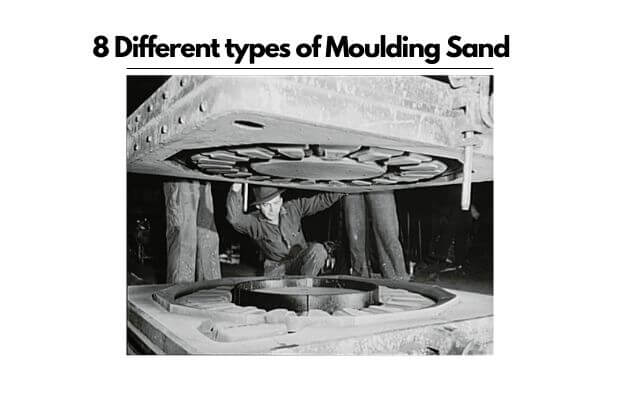Different types of Moulding Sand:
The below are the types of Moulding sand, classified according to their use:
- Backing sand
- Green sand
- Dry sand
- Core sand
- Loam sand
- Facing sand
- Parting sand
- System sand
1 Backing sand
Backing sand is a type of moulding sand which is also called as floor sand is used to back up the facing sand. It is used to fill the whole volume of the moulding flask. Backing sand sometimes called as black sand because repeatedly used moulding sand is black in color due to addition of coal dust and burning due to in contact with the molten metal.
2 Green sand
Green sand is a type of moulding sand which is also known as tempered or natural sand. Because it is a prepared with a mixture of silica sand with 18 to 30% clay and it has moisture content from 6 to 8%. Green sand is fine, soft, light, and porous. Green sand is wet, when this sand is squeezed, It retains the shape and impression of the given pressure.
Moulds prepared by this sand are not requiring backing and hence are known as green sand molds. Green sand is easily available and cost effective. it is commonly employed for production of ferrous and non-ferrous castings.
Also Read : What is Green Concrete? Advantages | Disadvantages | Properties
3 Dry sand
Dry sand are the green sand that has been dried or baked in suitable oven after the making mould and cores. Dry sand possesses high strength, rigidity and thermal stability. These types of moulding sand are mainly used for larger castings. Mould prepared with dry sand are known as dry sand moulds.
4 Core sand
Core sand is also known as Oil sand. which is used for making cores. These types of moulding sand are highly rich in silica sand mixed with oil binders like core oil.
Core oil is a mixture of linseed oil, resin, light mineral oil and other bind materials. While considering the economy, pitch or flour and water are used for making large cores.
5 Loam sand
Loam sand is a mixture of clay, sand and water. Which is possess high clay rages 30-50% and water of 18%.
In these types of moulding sand patterns are not used and used for moulding of large iron casting.
6 Facing sand
The name itself describes, this sand forms the face of the moulds. Facing sand is next to the pattern layer surface and which comes in direct contact with the molten metal, when the molten is poured into the mould.
Facing sand posses high strength and refractivity when it comes in contact with molten metal.
7 Parting sand
Parting sand is used to avoid sticking of green sand to the pattern. It also allows easy removal of cope and drag.
Parting sand is pure clay free silica sand.
8 System sand
In mechanical sand preparation and handling units, facing sand is not encountered. The sand that is used is cleaned and reactivated by adding water, binder and special additives. And the sand we get it is called system sand.
The system sand is used to fill the entire flask in the mechanical casting where machine moulding is employed. The moulds made of this sand has high strength, permeability and refractivity.
Also Read : Folded plates | Types of Folded Structure | Advantages & Disadvantages

